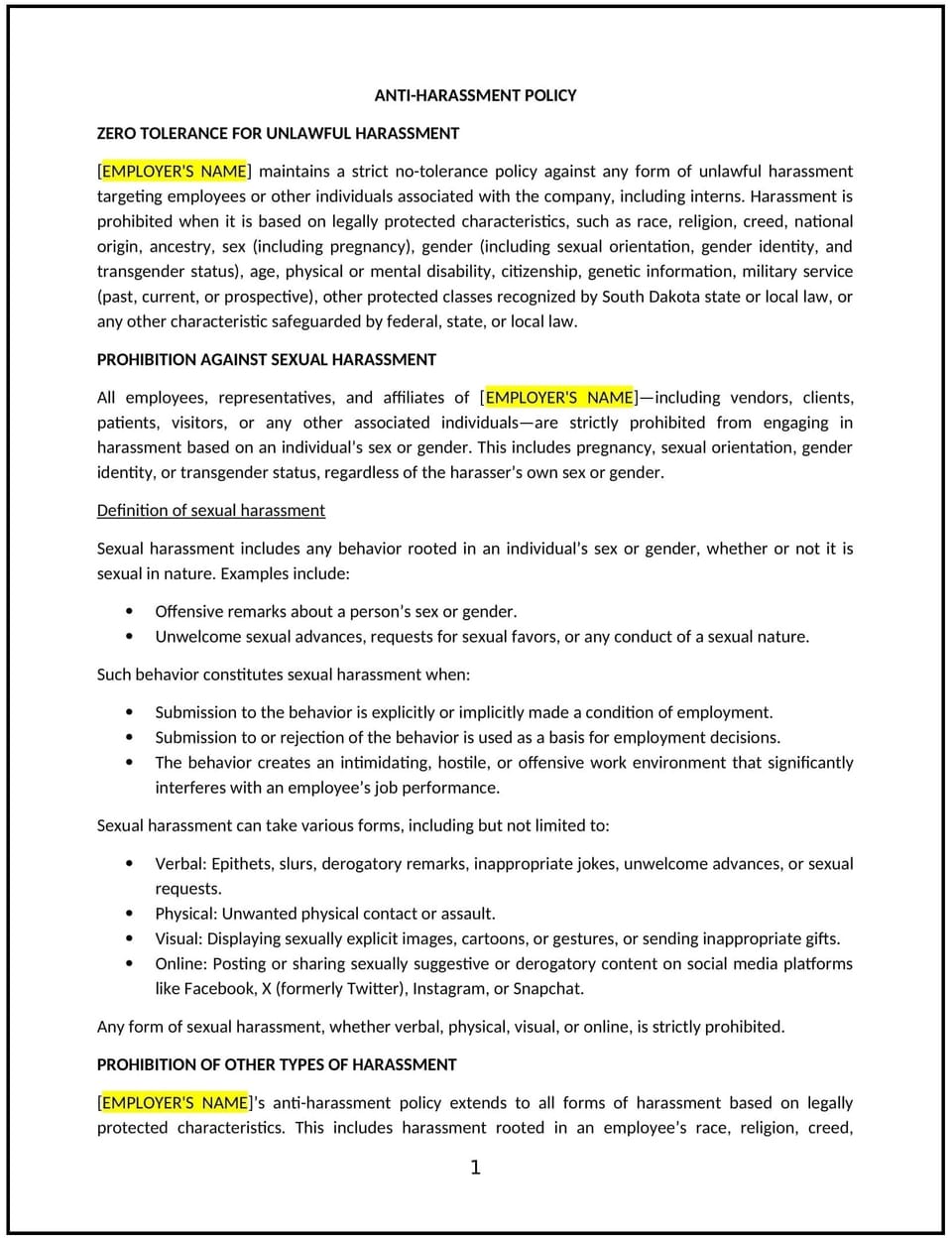Anti-harassment policy (South Dakota): Free template

Anti-harassment policy (South Dakota)
This anti-harassment policy is designed to help South Dakota businesses create a respectful and inclusive work environment by addressing and preventing harassment. It outlines procedures for reporting, investigating, and addressing incidents of harassment.
By adopting this policy, businesses can foster a positive workplace culture, reduce turnover, and promote employee well-being.
How to use this anti-harassment policy (South Dakota)
- Define harassment: Explain what constitutes harassment, such as verbal abuse, discrimination, or unwanted advances.
- Establish reporting procedures: Provide clear steps for employees to report incidents of harassment.
- Outline response protocols: Specify how the business will respond to reported incidents, including investigations and disciplinary actions.
- Train employees: Educate employees on recognizing harassment, reporting procedures, and fostering a respectful workplace.
- Implement preventive measures: Include strategies such as conflict resolution training, team-building activities, and open communication channels.
- Review and update: Assess the policy annually to ensure it aligns with evolving business needs and workplace standards.
Benefits of using this anti-harassment policy (South Dakota)
This policy offers several advantages for South Dakota businesses:
- Promotes a respectful workplace: Creates a culture of inclusivity and mutual respect among employees.
- Reduces turnover: Addresses harassment behavior, which can lead to higher employee retention.
- Enhances productivity: Encourages employees to focus on their work without fear of harassment or intimidation.
- Builds trust: Demonstrates a commitment to employee well-being and a safe work environment.
- Supports reputation: Positions the business as a responsible and caring employer in the community.
Tips for using this anti-harassment policy (South Dakota)
- Communicate the policy: Share the policy with employees and include it in the employee handbook.
- Provide training: Educate employees and managers on recognizing harassment behavior and reporting procedures.
- Monitor incidents: Regularly review reported incidents to identify patterns and address potential risks.
- Address issues promptly: Take immediate action to investigate and resolve reported incidents of harassment.
- Update regularly: Assess the policy annually to ensure it aligns with evolving business needs and workplace standards.
Q: How does this policy benefit businesses?
A: By addressing workplace harassment, businesses can create a respectful environment, reduce turnover, and enhance productivity.
Q: What types of behavior are considered harassment?
A: Harassment includes verbal abuse, discrimination, unwanted advances, or any behavior that creates a hostile work environment.
Q: How should businesses handle reported incidents of harassment?
A: Businesses should investigate reported incidents promptly, take appropriate disciplinary action, and provide support to affected employees.
Q: Can businesses implement preventive measures to reduce workplace harassment?
A: Yes, businesses can implement measures such as conflict resolution training, team-building activities, and open communication channels.
Q: How often should businesses review this policy?
A: Businesses should review the policy annually or as needed to ensure it aligns with evolving workplace standards and business needs.
This article contains general legal information and does not contain legal advice. Cobrief is not a law firm or a substitute for an attorney or law firm. The law is complex and changes often. For legal advice, please ask a lawyer.


